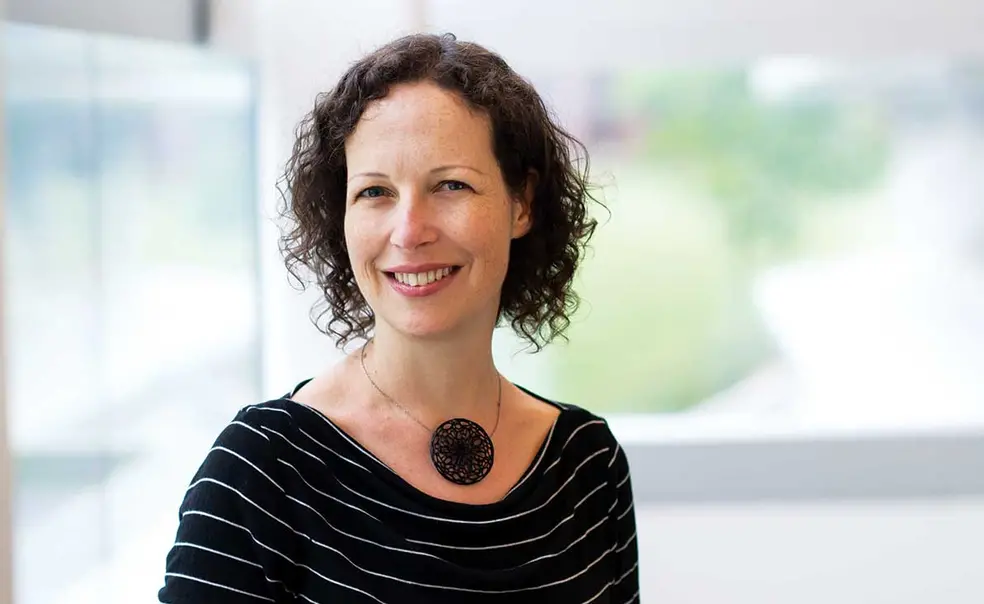Professor Yael Niv Is Blending Neuroscience and Psychiatry
With two disciplines, Niv’s new center is tackling the thorniest questions in psychiatry
Professor Yael Niv spent much of her career on basic research, content to puzzle over the fundamental principles of human learning, memory, and decision-making without much of an eye to how they could be applied. But that all changed in 2012, when she attended a talk by the Swiss neuroscientist Klaas Stephan, who opened with a challenge to his fellow computational cognitive neuroscientists: Psychiatry is in trouble, he declared, and it’s our fault.
Stephan saw a problem in the communication between psychiatry — the medical field dealing with disorders of cognition, emotion, and mental well-being — and the young field of computational cognitive neuroscience. That field uses new neuroimaging techniques, behavioral studies, and computer models “to understand the processes of learning, memory, attention, cognitive control, in a way that really was not there 30 years ago,” says Niv. But Stephan worried that neuroscientists weren’t talking to psychiatrists about the medical conditions that they and their patients spend every day trying to understand.
“I’d never thought of that before,” says Niv. “I really took it to heart.” Since then, she has redirected much of her research towards psychiatry, even taking a year off to train towards becoming a licensed cognitive behavioral therapist.
In 2015, with then-Rutgers professor Steve Silverstein (now at the University of Rochester), she founded the Rutgers-Princeton Center for Computational Cognitive Neuro-Psychiatry (CCNP), which aims to use new neuroscience to tackle some of the thorniest questions in psychiatry.
Most of us have heard of diagnoses like depression, schizophrenia, and bipolar disorder. But psychiatry has been continually tweaking and updating the definitions of these disorders for more than a century, and even today the categories are hardly clear-cut.
“On the one hand, it seems like we have too many diagnostic categories,” says Niv, explaining that conditions like obsessive-compulsive disorder and depression often occur together, more often than can be explained by chance. Maybe, beneath the surface, there’s some shared trait that could lead to the development of either disorder, or both, in a given patient. “On the other hand,” she says, “it’s almost like we have too few categories, because if you look at one person with depression, and someone else with the same diagnosis, they could be completely different,” showing distinct symptoms and responding to different treatments.
Others have tried and failed to perfect the diagnostic categories that psychiatry uses. But the goal of the CCNP, and computational psychiatry in general, is “more than finding the correct names” for a given set of symptoms, says Niv. “It’s understanding the mechanisms by which things work or go awry in each case, so that we can design better treatments or match the right treatment to the right patient.”
To that end, studies at the CCNP focus less on each patient’s specific diagnosis than on the relationship between symptoms and behavior, and the computations performed by the brain. One study examined “mood reactivity” — the degree to which one’s mood and one’s subjective experience of something influence each other. (A good mood may make things seem better than they are, and likewise, a good experience may improve mood.) “Strong mood reactivity could cause instability and severe mood fluctuations,” says Niv. One might expect that mood reactivity would be strongest in patients with bipolar disorder, who oscillate between extreme highs and depressive lows in their mood. But the researchers also found mood reactivity in people with major depression and bipolar depression, as well as in people without a psychiatric diagnosis, Niv says. Self-reported symptoms, rather than diagnosis, were predictive of mood reactivity, she says.
Data from these studies are used to construct computational models of how the physical structure of the brain must function for a given set of symptoms to relate to performance on a given task. It’s exactly this sort of model that computational neuroscience has used to understand how memory or learning actually work; Niv hopes that computational neuropsychiatry can do the same thing for mood, behavior, and other psychiatric symptoms.












1 Response
Marcelo Merino *78
3 Years AgoUnderstanding Brains and Emotions
This article was illuminating of the tremendous progress in research in this field that affects our humanity. I am an engineer who, in my retirement, have had the time to explore what other scientists do. I encourage continued work in understanding our brains and emotions.